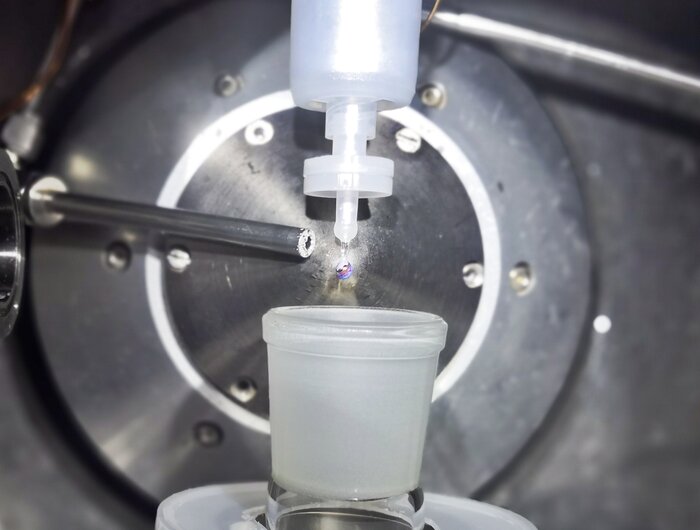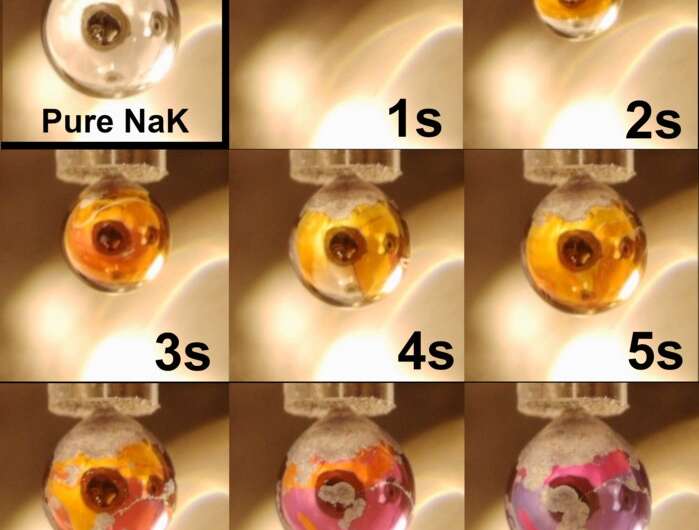
[ad_1]

In the sample chamber, the NaK alloy drips from a nozzle. As the droplet grows, water vapor flows into the sample chamber and forms a thin skin on the surface of the drop. Credit: HZB
Under normal conditions, pure water is an almost perfect insulator. Water only develops metallic properties under extreme pressure, such as it exists deep in the great planets. Today, an international collaboration has used a completely different approach to produce metallic water and documented the phase transition at BESSY II. The study is now published in Nature.
Every child knows that water conducts electricity, but it is “normal” running water that contains salts. Pure distilled water, on the other hand, is an almost perfect insulator. It consists of H2O molecules that are weakly linked to each other by hydrogen bonds. The valence electrons remain bound and are not mobile. To create a conduction band with free moving electrons, the water would have to be pressurized to such an extent that the orbitals of the outer electrons overlap. However, a calculation shows that this pressure is only present at the heart of large planets like Jupiter.
Provide electrons
An international collaboration of 15 scientists from eleven research institutes have now used a completely different approach to produce for the first time an aqueous solution with metallic properties and have documented this phase transition at BESSY II. To do this, they experimented with alkali metals, which very easily release their external electron.
Avoid the explosion
However, the chemistry between alkali metals and water is known to be explosive. Sodium or other alkali metals immediately begin to burn in water. But the team found a way to control this violent chemistry: They didn’t throw a lump of alkali metal into the water, but they did it the other way around: they put a tiny bit of water on a drop of alkali metal, a sodium-potassium alloy (Na-K), which is liquid at room temperature.

The first image shows a pure drop of sodium-potassium alloy; in the following images, we see the drop exposed to the action of water vapor at 10-4 mbar. A layer of water forms on the drop, in which the electrons released from the metal dissolve, giving it a golden metallic sheen. Credit: Phil Mason / IOCB Prague
Experience at BESSY II
At BESSY II, they set up the experiment in SOL3PES high vacuum sample chamber on the U49 / 2 beamline. The sample chamber contains a fine nozzle from which the liquid Na-K alloy drips. The silver droplet grows for about 10 seconds until it detaches from the nozzle. As the droplet grows, some of the water vapor flows into the sample chamber and forms an extremely thin skin on the surface of the droplet, only a few layers of water molecules. This almost immediately causes the electrons as well as the metal cations of the alkali alloy to dissolve in the water. The electrons released in water behave like free electrons in a conduction band.
Golden water skin
“You can see the phase transition to metallic water with the naked eye! The silver sodium-potassium droplet is covered with a golden glow, which is very impressive, ”reports Dr Robert Seidel, who supervised the experiments at BESSY II. The thin layer of golden metallic water remains visible for a few seconds. This allowed the team led by Professor Pavel Jungwirth, Czech Academy of Sciences, Prague, to prove by spectroscopic analyzes at BESSY II and at the IOCB in Prague that it is indeed water at the metallic condition.
Metal phase fingerprints
The two determining imprints of a metallic phase are the plasmon frequency and the conduction band. The groups were able to determine these two quantities using optical reflection spectroscopy and synchrotron X-ray photoelectron spectroscopy: while the frequency of the gold-colored metallic “water skin” plasmons is around 2.7 eV. (i.e. in the blue range of visible light) the conduction band is about 1.1 eV wide with a sharp Fermi edge. “Our study not only shows that metallic water can actually be produced on Earth, but also characterizes the spectroscopic properties associated with its magnificent golden metallic luster,” says Seidel.
Philip E. Mason et al, Spectroscopic evidence of a metallic aqueous solution of gold color, Nature (2021). DOI: 10.1038 / s41586-021-03646-5
Provided by the Helmholtz Association of German Research Centers
Quote: Water as a metal (2021, July 28) retrieved July 29, 2021 from https://phys.org/news/2021-07-metal.html
This document is subject to copyright. Other than fair use for private study or research purposes, no part may be reproduced without written permission. The content is provided for information only.
[ad_2]
Source link